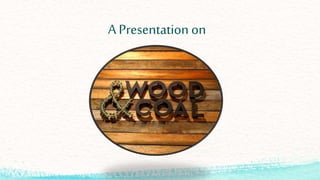
Coal
- 2. Topics Wood WoodCharcoal Peat Coals’ Origin Composition Characteristics significanceof its constituents
- 3. Wood A domestic fuel Used in tropical countries Basically cellulose & lignin
- 4. Features of Wood Easy ignition Low ASH content (<1%) Burns with long non-smoky flame Low calorific value (4000-5000) ------Because of high O2 content(45%) Produce Wood Charcoal & Producer Gas
- 5. Charcoal A bit Superior fuel than Wood Found from wood carbonisation
- 6. Carbonisation Heating in absence of air Moisture Removed Volatile matters Reduces Produces CHARCOAL Byproducts are Wood gas,tar etc As a result:
- 7. Features of Charcoal High calorific value (7500-8000 kcal/kg) High specific surface area Poor mechanical strength Raw material for CS2 Used for removing obnoxious and colouring materials
- 8. Peat First stage of coal formation from wood Most immature coal or Originates from Vegetable matter
- 9. Features of peat Friable Composition & property varies place to place Moderate calorific value Low furnace temperature & efficiency Used for fertilizer and power generation
- 10. Coal
- 11. Coal Combustible black or brownish black sedimentary rock Occurs in the earth’s crust Formed by partial decay of plant materials A runtime of several million years Driven by bacteria,temperature and pressure
- 12. Origin & Formation of coal Burial Pressure Heat Time Bacterial decay
- 13. Formation of coal Geological aspects In situtheory Drift theory
- 14. Formation of coal Peat Lignite Brown-coal Sub-Bituminus Bituminus Semi-anthracite Anthracite Graphite
- 15. Rank of coal Peat Lignite Bituminus Anthracite Moisture content decreases Volatile matter decreases Carbon content increases Calorific value increases Hardness increases
- 16. Peat Starting point of coal formation High moisture content Carbon : 60-64% Oxygen : 35-30% Coparatively low CV Light brown colour
- 17. Lignite Second stage of coal formation Moisture up to 60% Carbon : 60-75% Oxygen : 30-20% Brown appearance CV of 5000 kcal/kg
- 18. Sub-Bituminus Low moisture content Carbon : 70-80% Oxygen : 10-20% Black and Smooth CV of 7000 kcal/kg No caking power
- 19. Bituminus Low moisture content (<10%) Carbon : 75-90% Oxygen : 5-10% Black and Brittle CV of 9000 kcak/kg
- 20. Semi anthracite Harder than bituminous coal Carbon : 90-93% Oxygen : 1-4% Also known as Steam coal CV of 8600 kcal/kg
- 21. Anthracite Highest rank of coal Very low moisture content Carbon : 93+% Oxygen : 1-2% Harder,glossy and black Zero caking power CV of 8000-8500 kcal/kg
- 22. Graphite Technically the highest rank Difficult to ignite Not used as fuel
- 23. Unusual Coals Found Rarely High H2 content Does not fall in any category Channelcoal :
- 24. Unusual Coals Also known as boghead coal Rich in parafin oil Does not fall in any category Torbanites :
- 25. Analysis of Coal Proximateanalysis Ultimate analysis Heating/Calorific value
- 26. Proximate analysis 1. Moisture content 2. Volatile matter 3. Ash content 4. Fixed carbon Parametes :
- 27. Ultimate Analysis Parameters : 1. Carbon 2. Hydrogen 3. Oxygen 4. Sulphur 5. Nitrogens 6. Chlorine Mercury
- 28. Effects of the componants Moisture : Reduces Calorific value Increase coal consumption for heating purpose Lengthens time for heating Aids radiation heat transfer
- 29. Effects of the componants Volatile matter : Lowers ignition temperature Reduces calorific value Increase quantity of coke oven gas Sets minimum limit on furnace size
- 30. Effects of the componants Ash content : Reduces calorific value Reduces burning capacity Causes Clinkering an Slagging
- 31. Effects of the componants Fixed Carbon : Increases the Calorific value with constant proportionality
- 32. Effects of the componants Hydrogen : Increases the Calorific value
- 33. Effects of the componants Oxygen : Reduces the Calorific value Reduces Caking power
- 34. Effects of the componants Nitrogen : Reduces the Calorific value
- 35. Effects of the componants Sulphur : Increases Calorific Value Creates corrosive environment Causes HOT-SHORTNESS Limits exit flue gas temperature
- 36. Effects of the componants Chlorine : Reduces fusion points of ash in coal
- 37. Effects of the componants Phosphorus : Creates COLD-SHOTNESS in steelmaking
- 38. Uses of Coal 85% for electrical power generation. 15% for manufacturing as Coke.
- 39. References • Elements of Fuels, Furnaces & Refractories -By O.P. Gupta • http://f03.classes.colgate.edu/fsem037- coal/Coal/Default/composition_of_coal.htm • https://www.worldcoal.org/coal • https://www.uky.edu/KGS/coal/coalform.htm • http://www.coaleducation.org/q&a/how_coal_formed.htm
- 40. Presented by : Nabila Ali (1311035) Shimul Chandra Das (1311034) Mehedi Mehetab Shihab (1311029)